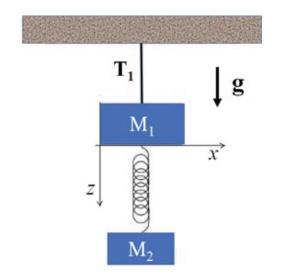Two blocks of mass (M_{1}=1.20 mathrm{~kg}) and (M_{2}=0.25 mathrm{~kg}) are hung as in Fig. 4.15: (M_{1}) is
Question:
Two blocks of mass \(M_{1}=1.20 \mathrm{~kg}\) and \(M_{2}=0.25 \mathrm{~kg}\) are hung as in Fig. 4.15: \(M_{1}\) is hung from the ceiling by an inextensible wire of negligible mass, while \(M_{2}\) is hung from \(M_{1}\) by an ideal spring of elastic constant \(k=30 \mathrm{~N} / \mathrm{m}\) and rest length \(L_{0}=20 \mathrm{~cm}\). At the initial instant \((t=0)\) the bodies are stationary and the spring is compressed from below, with distance between \(M_{1}\) and \(M_{2}\) equal to \(L_{0} / 2\). In the next motion, \(M_{2}\) descends until it reaches a maximum distance \(L_{\max }\) from \(M_{1}\). Calculate 1. the value of the tension \(T_{1}\) at the initial time;
2. the equilibrium position for the spring, calculated with respect to the base of the mass \(M_{1}\);
3. show that the restoring force of the spring produces an elastic force with respect to the determined equilibrium position. Calculate in that case:
4. the value of \(L_{\max }\), and the corresponding new value of tension \(T_{1}\);
5. the maximum speed reached by \(M_{2}\) during the descent.
Fig. 4.15

Step by Step Answer:






